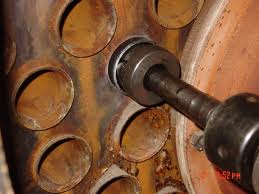Boiler Surveys (Including Thermal Oil Heaters)
General
A complete survey means a lull internal and external examination of all parts of the boiler and accessories such as super heater, economizer, air-heater internal organs and all mountings. This examination may lead the Surveyor to require thickness gauging of plate or tubes that appear to be wasted and eventually to a lower assigned working pressure, if calculations prove this necessary.
Plugging of Boiler Tubes
General
A complete boiler survey allows us to check out if any build-up of deposits has taken place, and deformations or wastage of plate work, piping or any of the various parts, which may compromise the sale working order of the unit. The survey should include research as to cause of any anomalies found and also their correction.
A complete survey means a lull internal and external examination of all parts of the boiler and accessories such as super heater, economizer, air-heater internal organs and all mountings. This examination may lead the Surveyor to require thickness gauging of plate or tubes that appear to be wasted and eventually to a lower assigned working pressure, if calculations prove this necessary.
Collision chocks, rolling stays and boiler stools are to be examined. The oil fuel burning system is to be examined under working conditions and safely devices are to be checked, including any automatic burner light-up sequence to verify purging of the furnace prior to lighting burners. A general examination is to be made of fuel tank valves, pipes etc. and fuel pipes between pumps and burners.
Safety valves are to be adjusted to a pressure not greater than 105 % of design pressure.
Water-tube boilers
 |
| Typical survey plan |
The main points to remember are:
- At superheat temperatures > 400 °C special steels and more advanced welding techniques will be involved.
- Check drawings of unfamiliar designs of boiler to correctly plan the survey.
Steam drum and tubes
|
Pitting, fit of manhole door
|
Super heater
|
Short-circuiting, erosion in headers. Weld fractures.
|
Boiler casing
|
Overheating, leakage.
|
Furnace
|
Distortion of tubes, bulging of tubes. Condition of baffles Refractory.
|
Water drums
|
Pitting fit of manhole door.
|
Scotch boiler type
 |
| Typical survey plan |
The main points to remember are:
- Boiler should be thoroughly cleaned and prepared for survey.
Furnaces
|
Overheating and subsequent distortion
|
Combustion Chambers
|
Overheating and distortion of crown.
Leaking tubes and stays.
|
Tubes
|
Thinning at ends, repeated expansion.
|
Shell Internal
|
Wastage, grooving
|
Shell External
|
Wastage, in way of leaking mountings.
|
Cochran type boiler
The main points lo remember for these varied designs are similar to the foregoing:
- Wastage, lire and water side.
- Deformations due to overheating.
- Leaking lubes.
- Wastage externally due lo leaking mountings, manholes and handholds.
Hydraulic testing
Following major repairs or as required by the Surveyor hydraulic testing may be required.
Hydraulic test of boilers in service
P = Working pressure in bars.
Before 1.25 P if P < 40
12th year 1.2 P + 2 if P > 40
After 1.15 P whatever P
12th year value
 |
| Typical safety valve designs |
Pressure tightness tests at working pressure may also be carried out after small maintenance jobs such as part re-tubing, renewal of rivets or extensive caulking of seams or rivets, welding of small cracked areas.
Plugging of Boiler Tubes
Water tube boilers
Screen tubes - These are the first rows of tubes and are exposed directly to the flame, they are gene rally very closely slacked lo afford protection to the super-heater elements which lie behind.
Wale wall tubes - these are subject to the same defects as screen tubes, but more sensitive to poor circulation, particularly roof tubes.
Main steam generating lube bank - a maximum of 10 % of the tubes may be accepted plugged before renewals are required.
Note: In all cases of boiler problems it is important to ascertain the cause of damage (flame impingement, lack of boiler water treatment etc.) and take remedial action.
Smoke tube boilers
Any tubes found plugged should be renewed.
Tubes with excessive thinning at the ends because of repeated rolling or showing signs of movement should be renewed.
The maker’s instructions should be consulted where available.






